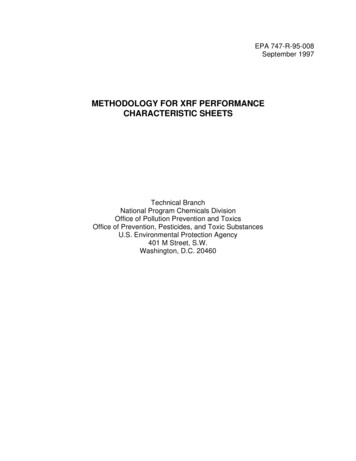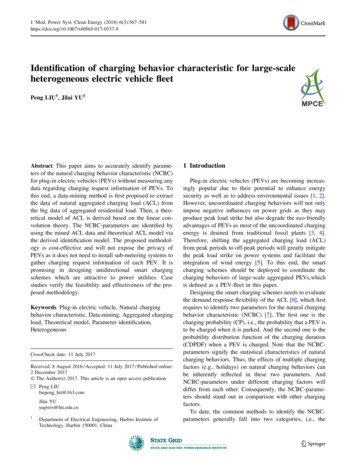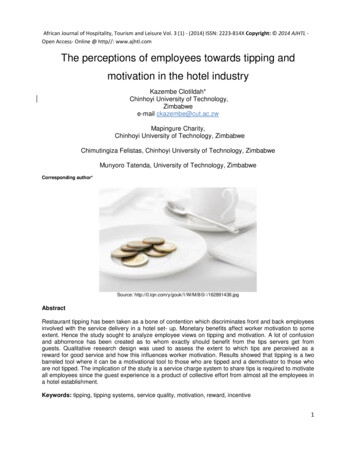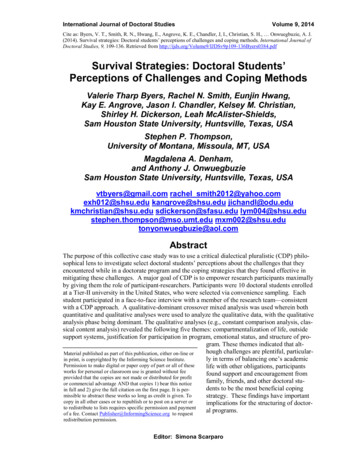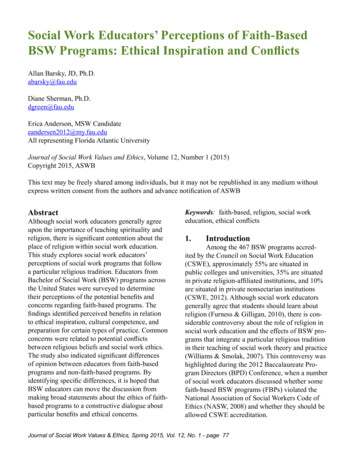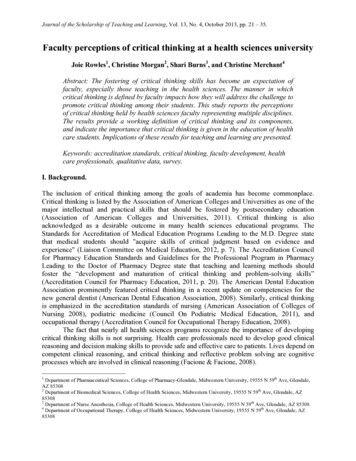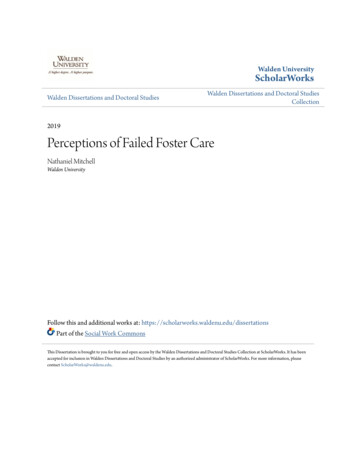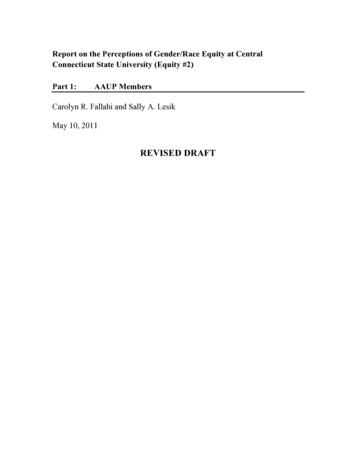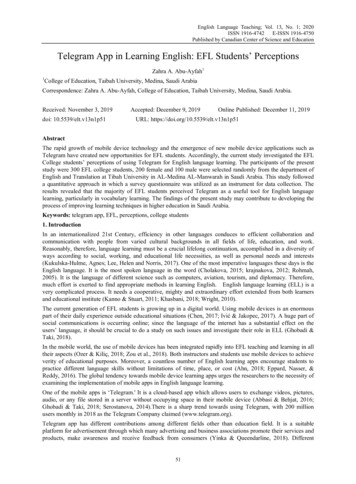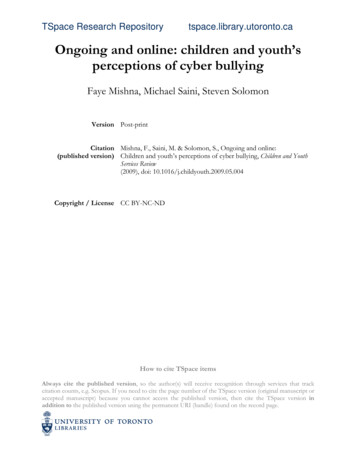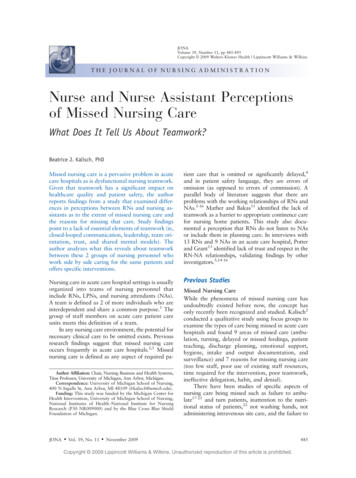
Transcription
THE APPLICATION OF HACKMAN AND OLDHAM’S JOBCHARACTERISTIC MODEL TO PERCEPTIONS COMMUNITY MUSICSCHOOL FACULTY HAVE TOWARDS THEIR JOBRobert M. Lawrence, B.A., M.M.E.Dissertation Prepared for the Degree ofDOCTOR OF PHILOSOPOHYUNIVERSITY OF NORTH TEXASAugust 2001APPROVED:Dr. Hildegard Froehlich, MajorProfessor and Program Coordinatorfor Music EducationDr. Kris Chesky, Minor ProfessorDr. Warren Henry, Committee Member andChair of the Department of MusicEducationDr. Darhyl Ramsey, Committee MemberDr. Tom Clark, Dean of the College ofMusicC. Neal Tate, Dean of the Robert B.Toulouse School of Graduate Studies
Lawrence, Robert M., The Application of Hackman andOldham’s Job Characteristic Model to Perceptions CommunityMusic School Faculty Have Towards Their Job.Doctor ofPhilosophy (Music Education), August 2001, 167 pp., 25tables, 25 figures, bibliography, 37 titles.Hackman and Oldham’s Job Characteristic Model wasapplied to study of perceptions community music schoolfaculty hold towards their job.The research questionsaddressed core job characteristics of skill variety, taskidentity, task significance, autonomy, and feedback,critical psychological states (experienced meaningfulness,experienced responsibility, and knowledge of results);personal and work outcomes of satisfaction and motivation;need for professional growth. The results were compared tothe national norms for nine different job families providedby Oldham, Hackman, and Stepina.Thirty-three schools, allmembers of the National Guild of Community Schools of theArts, located in every geographical region of the UnitedStates, yielded 437 faculty responses (64% return rate).Of the core job characteristics, dealing with others andautonomy received the highest ratings; feedback and tasksignificance received the lowest ratings.Of the
psychological states, experienced responsibility yieldedthe highest rating and experienced meaningfulness yieldedthe lowest ratings.Of the personal/work outcomes,personal development and colleague relations received thehighest ratings; pay satisfaction and overall generalsatisfaction received the lowest ratings.A comparison tothe professional job family norms, using a one-sample ttest, found significant differences in 16 out of the 18variables measured by the Job Characteristic Model.Strongpositive feelings for growth combined with less than strongfeelings for the core job dimensions yielded a lowmotivating potential score of 96.18.
TABLE OF CONTENTSPageLIST OF TABLES . . . . . . . . . . . . . . . . . . . .ivLIST OF FIGURES . . . . . . . . . . . . . . . . . . . . viiChapterI.INTRODUCTION . . . . . . . . . . . . . . . . . . 1RationaleBackgroundPurpose and ProblemsDefinition of TermsDelimitationsII.RELATED LITERATURE. . . . . . . . . . . . . .19Historical Background of Job Design and MotivationDescription of Job Diagnostic SurveyNorms of the Job Diagnostic SurveyThe Job Diagnostic Survey in EducationIII.METHODOLOGY . . . . . . . . . . . . . . . . . .64Instrumentation and Data Collection ProceduresPopulation, Sample, and SubjectsData Analysis TechniquesIV.RESULTS . . . . . . . . . . . . . . . . . . . .90Data AnalysisComparison of Results to National NormsV.SUMMARY, CONCLUSIONS AND DISCUSSION . . . . . .SummaryConclusionsDiscussionii114
APPENDICES . . . . . . . . . . . . . . . . . . . . . .136REFERENCES . . . . . . . . . . . . . . . . . . . . . .164iii
LIST OF TABLESTable 1The Motivating Potential Score formulaas computed by Hackman and Oldham . . . . . . . 7Table 2Question from Section One of theJob Diagnostic Survey of Hackman and Oldham . . 27Table 3Question from Section Two of theJob Diagnostic Survey of Hackman and Oldham . . 28Table 4A Question from Section Eight of theJob Diagnostic Survey of Hackman and Oldham . . 33Table 5Internal Consistency Reliabilities of theJob Diagnostic Survey Reported byOldham, Hackman, and Stepina . . . . . . . . . 36Table 6Job Diagnostic Survey Means andStandard Deviations Across Respondentsand Jobs . . . . . . . . . . . . . . . . . . . 38Table 7Job Diagnostic Survey Items Used to MeasureJob Dimensions . . . . . . . . . . . . . . . . 67Table 8Job Diagnostic Survey Items Used to MeasureCritical Psychological State . . . . . . . . . 67Table 9Job Diagnostic Survey Items Used to MeasurePersonal/Work Outcomes . . . . . . . . . . . . 68Table 10Job Diagnostic Survey Items Used to MeasureIndividual Growth Need Strength . . . . . . . . 69Table 11The Motivating Potential Score Formula of theJob Diagnostic Survey of Hackman and Oldham . . 70Table 12Geographical Distribution of SchoolsParticipating in Study . . . . . . . . . . . . 74iv
Table 13Means and Standard Deviations of Job Dimensionsfor Community Music School Faculty . . . . . . 92Table 14Motivating Potential Score of the CommunityMusic School Teaching Job . . . . . . . . . . . 93Table 15Means and Standard Deviations of the ThreePsychological States for Community MusicSchool Faculty . . . . . . . . . . . . . . . . 94Table 16Personal/Work Outcomes Obtained from aCommunity Music School Teaching Job . . . . . . 96Table 17Growth Need Strength of Community MusicSchool Faculty . . . . . . . . . . . . . . . . 98Table 18Means for the Job Dimensions of the CommunityMusic School Job and the Nine Job FamiliesUsed to Establish the National Norms . . . . . 101Table 19One Sample t-test Comparing the Core JobDimensions Means of the Professional JobFamily and the Community Music School Job . . 104Table 20Means for the Psychological States of theCommunity Music School Job and the Nine JobFamilies used to Establish the National Norms 105Table 21One Sample t-test Comparing the PsychologicalState Means of the Professional Job Familyand Community Music School Job . . . . . . . 107Table 22Means for the Personal/Work Outcomes of theCommunity Music School Job and the Nine JobFamilies used to Establish the National Norms 108Table 23One Sample t-test Comparing the Personal/WorkOutcome Means of the Professional Job Familyand Community Music School Job . . . . . . . . 110v
Table 24Means for the Growth Need of the CommunityMusic School Faculty and the Nine JobFamilies used to Establish the National Norms 111Table 25One Sample t-test Comparing the Growth NeedMeans of the Professional Job Family andCommunity Music School Job . . . . . . . . .vi113
LIST OF FIGURESFigure 1The Relationships Among the Core Job Dimensions,the Critical Psychological States, Personal/WorkOutcomes, and Moderators as illustrated byHackman and Oldham . . . . . . . . . . . . . . 5Figure 2Questions from Section Three of theJob Diagnostic Survey of Hackman and Oldham . . 29Figure 3Question from Section Five of theJob Diagnostic Survey of Hackman and Oldham . . 29Figure 4Questions from Section Three and Fiveof the Job Diagnostic Survey ofHackman and Oldham . . . . . . . . . . . . . . 30Figure 5Questions from Section Four of theJob Diagnostic Survey of Hackman and Oldham . . 31Figure 6A Question from Section Six of theJob Diagnostic Survey of Hackman and Oldham . . 32Figure 7Gender Distribution of Subjects . . . . . . . . 75Figure 8Age Distribution of sample . . . . . . . . . . 76Figure 9Distribution of Degrees held by Subjects . . . 77Figure 10 Music Education Degrees held by Subjects . . . 78Figure 11 Public School Certification . . . . . . . . . . 79Figure 12 Distribution of Instrument Families . . . . . . 80Figure 13 Professional Teaching Experience . . . . . . . 81Figure 14 Years of Service at School . . . . . . . . . . 82Figure 15 Number of Weekly Teaching Hours . . . . . . . . 83vii
Figure 16 Teaching is Sole Source of Income . . . . . . . 84Figure 17 Age Range of Students . . . . . . . . . . . . . 85Figure 18 Responsibilities at School . . . . . . . . . . 86Figure 19 Types of Teaching . . . . . . . . . . . . . . . 87Figure 20 Summary of Job Diagnostic Survey ResultsObtained from Community Music School Faculty . 99Figure 21 Graphic Representation of the Means forthe Job Dimensions of the ProfessionalJob Family and Community Music School Job . . 102Figure 22 Graphic Representation of the MotivatingPotential of the Professional Job Family andCommunity Music School Job . . . . . . . . . . 103Figure 23 Graphic Representation of the Means for thePsychological States of the Professional JobFamily and Community Music School Job . . . . 106Figure 24 Graphic Representation of the Means for thePersonal/Work Outcomes of the ProfessionalJob Family and Community Music School Job . . 109Figure 25 Graphic Representation of the Means for theGrowth Need of the Professional Job Familyand Community Music School Job . . . . . . . . 111viii
CHAPTER ONERATIONALE, BACKGROUND, PURPOSE AND PROBLEMS,DEFINITION OF TERMS, DELIMITATIONSRationaleStatistics produced by the National Guild of CommunitySchools of the Arts (1999) suggests that: (a) the oldestcommunity music school was founded in 1894 and the youngestis just a few years old; (b) 300,000 students, ranging inage from infants to senior citizens, participate in regularweekly instruction; (c) tens of thousands of people attendover 2,500 community music school performances, exhibitionsand lectures each year; (d) community music schools employmore than ten thousand professional artists and staffmembers and nearly sixty percent have ongoing partnershipswith public schools; (e) annual budgets range from fiftythousand to four million; (f) combined expenditures totalmore than one hundred million each year; and (g) themission of these schools is to foster and promote broadaccess to high quality arts education designed to meetcommunity needs. These statistics are impressive andsuggest that community music schools are thrivingeducationally and economically. However, there are only1
three studies that have examined systematically theeconomic, physical, and staffing conditions, as well as theoverall effectiveness of the community music schoolenvironment.In the 1960’s, Max Kaplan was invited by presidentRobert Fields of the National Guild of Community MusicSchools to prepare an assessment of the condition ofcommunity music schools and to offer recommendations foradministrative and academic improvement. After visitingmany of the community music schools throughout the UnitedStates, Kaplan (1966) completed his study and offered manyrecommendations, which included improving the workingconditions of employed music educators by providing bettercompensation packages. He proposed to offer music educatorsfull-time employment status that would be supported bysalaries instead of part-time positions with hourly rates.Alexander (1997) examined the relationship between fortycommunity music school programs and their affiliation withcollegiate music schools. Like Kaplan, he providedrecommendations that stressed the importance of improvingthe working conditions of music educators. Alexander alsopointed to the need of developing standards for evaluatingthe teaching performance of music educators through a2
review of administrative and peer evaluations.Additionally, he encouraged community music schools toexplore medical and pension benefit programs in order toretain qualified music educators with attractive andcompetitive employment packages.In a study on the members of the National Guild ofCommunity Schools of the Arts, Evans, Klein, and Delgado(1992) recommended to improve faculty working conditionsthrough an increase in the hourly rate of pay by providingnew and improved benefits, creating opportunities forprofessional development, and by establishing facultycouncils.All three studies, which span a thirty-year period,call for a job redesign to improve faculty workingconditions. All three studies also suggest by inferencethat insufficient compensation and benefit packages are thejob characteristics that cause inadequate workingconditions, poor faculty morale, and retention. However,the results of several studies conducted in variouseducational settings outside of music suggest that thereare various job characteristics in addition to compensationand benefits that significantly contribute to overall3
teacher effectiveness and satisfaction (Pasi, 1995;Gibbons, 1996; Morton, 1991; Barnabe and Burns, 1994).The job characteristics receiving the most researchattention to date have been those described by the JobCharacteristics Model and Job Diagnostic Survey developedby Hackman and Oldham (Nicholson, 1998). According toHackman and Oldham (1980), the Job Diagnostic Survey wasdesigned to diagnose job characteristics prior to anyeffort to redesign a job (p. 103). Using Hackman andOldham’s Job Characteristic Model, the purpose of thisstudy was to investigate the perceptions community musicschool faculty hold towards their job. Made operational bythe Job Diagnostic Survey, the model includes various corejob dimensions, psychological states, personal/workoutcomes, and growth-need strength variables that areexplained in the following section.Background of StudyThe Job Characteristics Model has its roots in thepioneering works of Herzberg (1966), Turner and Lawrence(1965), Blood and Hulin (1967) and Hulin and Blood (1968),all of who examined the relationship between certainobjective attributes of tasks and employees’ reactions to4
their work. On the basis of these works, Hackman and Oldhamdeveloped the theory that the job itself should be designedto possess fundamental characteristics needed to createconditions for high work motivation, satisfaction andperformance. The concepts of their Job CharacteristicsTheory are diagramed in Figure 1.Core JobCharacteristics·Skill Variety·Task Identity·Task Significance·Autonomy·FeedbackCritical PsychologicalStates·Meaningfulness of Work·Outcome Responsibility·Knowledge of ResultsPersonal/WorkOutcomesHigh Internal WorkMotivationHigh Quality WorkPerformanceModerator- Growth Need StrengthHigh Satisfactionwith the WorkFigure 1. The Relationships Among the Core Job Dimensions,the Critical Psychological States, Personal/Work Outcomes,and Moderators as i
community music school was founded in 1894 and the youngest is just a few years old; (b) 300,000 students, ranging in age from infants to senior citizens, participate in regular
